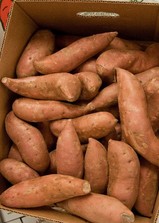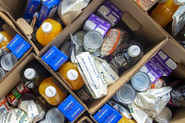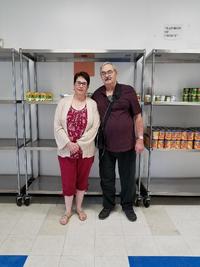Summary of Bonus Offerings to TEFAP in FY 2018
 Fiscal Year (FY) 2018 was a big year for bonus offerings in The
Emergency Food Assistance Program (TEFAP) as
USDA purchased over $400 million in food representing most of the major food
groups. USDA's Food and
Nutrition Service (FNS)
and Agricultural
Marketing Service (AMS) worked together to
purchase a variety of items to support domestic agricultural producers and
provide nutritious foods to emergency feeding organizations. This year included a rainbow of options from
the fruit group: canned peaches and mixed fruit; dried cherries and plums; and
frozen blueberries, strawberries, and raspberry puree. Raspberry puree was a new bonus offering in TEFAP and can be used in many different ways,
such as drizzling warm raspberry puree
on top of desserts or serving it as a topping for breakfast items such as
pancakes, waffles, or oatmeal.
In
addition to the fruit options, tomatoes, spaghetti sauce, beans, and fresh red
potatoes provided strong representation for the vegetable group. The protein group included three pork
items, six chicken items, turkey roasts, and catfish. The dairy group was represented by cheddar
cheese and fluid milk purchases. USDA hopes these
bonus foods supported programs in providing healthy, balanced pantry bags to families
across the country. We look forward to continuing
to provide a variety of bonus food items in the upcoming fiscal year.
|
Bonus Offerings: Inventory Management Reminders
USDA’s Agricultural Marketing Service (AMS) market support program
will be purchasing up to $1.2 billion in USDA Foods, as part of the trade mitigation efforts,
to support American agriculture producers affected by increased tariffs.
State
Distributing Agencies (SDA) and Recipient Agencies (RA) should practice
effective inventory management to ensure that bonus offerings of USDA Foods are
distributed in an efficient, timely manner and in optimal condition. Proper
handling and storage of USDA Foods throughout the distribution chain is
essential to maintain product quality and food safety. As a general rule, stock
should be rotated utilizing FIFO (“First In - First Out”) based on the type of
product, date the product was received, and product production or use by dates provided by the
manufacturer. RAs should determine an effective schedule for product distribution.
By taking the necessary precautions, food losses can be prevented.
 Warehousing
and distribution staff should be advised on how to properly receive and store
USDA Foods. Examining the product as it is being received helps to avoid problems
later. It is important that sufficient time is taken to inspect product, open
cases, and, if needed, open internal packaging to check product at time of
delivery. Take action immediately if the product does not meet the specifications.
Document and report any issues and provide supporting photos. SDAs should report all USDA
Foods complaints through the Web-Based Supply Chain Management system (WBSCM).
Certain types of USDA Foods, such as
dried fruits, grain products, and dairy products are more sensitive. If handled improperly, they may go
out-of-condition prior to the dates provided by the manufacturer. These types of items should be stored in a
cool, dry place at refrigerator or freezer temperatures, as applicable and in
accordance with proper storage guidelines, and should be distributed to program
recipients as soon as possible.
SDAs and RAs must
ensure that USDA Foods, including products distributed through bonus offerings, are stored in a way that protects them from infestation, spoilage, damage, or
other conditions that may jeopardize the wholesomeness and safety of the foods.
USDA Foods must be maintained in sanitary conditions, at the proper temperature
and humidity, and with adequate air circulation. All SDAs and RAs must ensure
that storage facilities have obtained all required Federal, State, and/or local
health inspections and/or approvals and such inspections/approvals are current.
For more information, review:
The
Complaint Team is available Monday-Friday, 6:00 a.m. – 5:00 p.m. Eastern Time.
|
Bonus Buy of Fresh, Fluid Milk
 Starting in October, USDA will distribute fresh, fluid milk to TEFAP sites as a bonus offering in FY 2019! USDA purchased nearly 63 million pounds and more than $20 million of skim, 1%, 2%, and whole milk. A good source of protein, calcium, and phosphorus, milk will be an excellent addition to the foods available for TEFAP recipients. Milk is fortified with vitamin D, which contributes to bone health. Vitamin D is found in few food sources and it can be difficult for your body to get enough from the sun especially during the cold winter months when the days are shorter. Milk is a versatile product that can be used simply in a bowl of cereal or added to a casserole or soup to thicken its consistency. Check out the USDA Mixing Bowl to find creative ways to use milk!
|
 New TEFAP Foods Available List
It’s the start of the new Federal fiscal year and the launch
of a new TEFAP USDA Foods Available List for the coming year! USDA is continuously seeking feedback from
State agencies, local programs, and other stakeholders in order to add or
reformulate items to better meet the needs of program recipients. You asked and USDA has delivered a variety of
new items to help meet the needs of food banks across the country, including
more fresh produce options, more individual portion items for backpack
programs, and more frozen protein options!
|
 The updated Foods Available List includes the following additions: fresh sweet potatoes and oranges; dried cranberries and peanut butter in individual servings; and Alaska Pollock fillets and fish sticks. Additionally, new formulations are available for the beef stew and the cream of mushroom soup to better meet customer expectations. We hope you will give these items a try and encourage you to send feedback about other new items you would like to see to USDAFoods@fns.usda.gov.
|
Smaller Package of
Nonfat Dry Milk Coming to CSFP
 As you may know, in
2017 USDA convened a workgroup of State and local program representatives to
provide input on the Commodity Supplemental Food Program (CSFP) Food Package. One recommendation that was clear
from the workgroup was that the larger package sizes of some food items were
challenging for both participants and programs to manage. USDA has been
working on a plan to introduce broader changes to the CSFP Food Package that
will be announced at a later date, but we are pleased to announce that
beginning as early as January 2019, a smaller package size of the nonfat dry
milk will be introduced into CSFP! The new package is 12.8
oz, which is half the size of the current 25.6 oz package. Thus, programs
will be able to issue one smaller unit monthly rather than one larger unit
every other month. We think it will be a positive change for all! Policy guidance has been issued through the FNS Regional Offices about this
change, but if you have other questions or feedback, feel free to contact your
FNS Regional office or email USDAFoods@fns.usda.gov.
|
CSFP Requests for Additional Caseload in 2019
Every year, currently participating CSFP State agencies and
Indian Tribal Organizations (ITOs) seeking to serve more eligible seniors in
their State are required to submit their request to their FNS Regional
Offices. This year’s deadline to request additional caseload slots, or
the number of individuals the State is authorized to serve, for the 2019
caseload cycle is November 5, 2018. We encourage States and local
agencies who are already fully utilizing existing caseload and who anticipate
expansion potential to request additional caseload slots for the 2019 cycle, in
accordance with program requirements at 7 CFR 247.21(a)(2). Final
caseload levels are subject to Congressional appropriations and available
program resources in FY 2019. For more information, please refer
to the “CSFP – Submission of State Plans and Additional Caseload Requests for
2019” memorandum, released on June 4, 2018.
Webinar Save the Date: How to Encourage Variety in CSFP
 How does your program decide what to put in the CSFP food boxes each month? How can planning and creating menus help ensure you provide seniors with a variety of items to meet their food needs? Join us for a webinar on Thursday, November 29 from 2:00-3:00 Eastern Time to hear from USDA and CSFP program representatives about best practices to ensure that your program can serve a variety of foods in the CSFP food boxes.
Stay tuned for details! Review your subscription preferences to ensure you are signed up for the "Webinars - CSFP" topic to receive registration information about this and future events.
|
Focus: HOPE CSFP Program in Detroit Offers Client Choice

In
August, USDA staff visited three CSFP distribution sites at Focus: HOPE in
Detroit, Michigan. The program director, Frank Kubik, provided an overview of the
program in Detroit that provides clients with the option to choose foods in
each category using a “client choice” program model. USDA staff observed clients selecting their food with the assistance of program volunteers, clients partaking in a CSFP food tasting through a recipe prepared by a site volunteer, and volunteers pre-packing CSFP boxes for delivery to local senior programs and residential facilities. Focus: HOPE offers clients a variety of services in a warm environment with caring staff and volunteers. We thank the team at Focus: HOPE for providing USDA with an inside look at the CSFP program in action and invite you to view more photos of our visit here.
|
Massachusetts Food Pantry Features Senior Food Choice Program
Article courtesy of Kim A. Kennedy, Development Director, and Nia Rennix, Director of Food Pantry Services, Open Pantry Community Services, Inc.
Open
Pantry's Emergency Food Pantry Senior Food Choice program is
specifically designed to meet the immediate and long-term goals of
disadvantaged seniors in greater Springfield, Massachusetts. The Emergency Food Pantry dedicates one day each month to
serve seniors only in a grocery store-like setting. The program is a nutrition education-based
program that promotes healthy eating based on the USDA MyPlate nutrition standards. The
Senior Food Choice Program is held the 3rd Monday of the month at a pantry in the north end of
Springfield, Massachusetts.
Seniors
are paired with a personal shopper to assist them while they choose their
preferred foods using their own shopping carts. The
program has removed the stigma associated with accessing a food pantry and provides dignity
to our seniors.
Our Emergency Food Program staff complete a comprehensive intake assessment for all seniors to ensure
they are receiving all available benefits they may be entitled to
based on their income. We screen for participation in the Supplemental Nutritional Assistance Program (SNAP), fuel assistance, and medical
insurance. If a senior is not participating in an eligible benefit, we will
refer them to the appropriate agency or assist in the application process. In
addition, we attempt to address each senior's needs, beyond food,
and make referrals for a variety of programs including free clothing and winter coats,
help with utility bills, and housing needs.
Our
seniors' lives change tremendously when they receive our services. We
find that they have reduced stress levels once they know that they can
access our food pantry on a monthly basis. Seniors also have an opportunity
to network with each other and exchange helpful information about additional
services that they may be eligible to receive. We also aim to help seniors make better nutrition choices by offering fresh fruit and produce at each
senior day along with recipes and food tastings
that will ultimately lead to healthier food choices and more nutritious meals
for our seniors.
 |
|
The seniors pictured to the left shared the following testimonial about the Open Pantry senior day:
“The Open Pantry helped us so much years ago when my
husband’s health was failing. We would come monthly and get delicious foods and
toiletries. This helped us to get back on our feet. Life can be cruel and hard.
Good hearts like the people at the Open Pantry restored our faith in people. I
am always happy to give back to the food pantry whenever I can. You can never
give enough or too much.”
|
Does your TEFAP or CSFP site have a story or best practice to share? Email USDAFoods@fns.usda.gov to be featured in an upcoming edition of this e-letter!
New User Requests for WBSCM
Each person
who will be accessing the Web-Based
Supply Chain Management system (WBSCM) is assigned a unique user profile.
Individuals who represent multiple organizations will have a separate user profile
for each of these organizations.
WBSCM uses eAuthentication
(eAuth) to manage login credentials. Only one eAuth account may be linked per
user profile in WBSCM. Creating an eAuth
account will not automatically grant access to WBSCM; a user profile
must be created by a WBSCM administrator.
New users
should contact the User Administrator for your organization (SDA, RA, ITO, etc.) to request access. Additional tips can be found in the WBSCM f.a.q.
Note: User Administrators can find guidance on creating a new
user profile in WBSCM under Help ->
Training -> Job Aids -> General Help -> WBSCM User Administration.
After the
profile has been created in WBSCM, the new user will receive an
email with instructions to create, activate,
and register their eAuth account. Most errors encountered
during registration result from selecting the wrong link in the email message
or not entering the Last Name and Email exactly the same way as in WBSCM.
Help for Forgotten Login Information
The service
desk teams for WBSCM cannot recover user login credentials. These
are maintained in a separate system called eAuthentication.
To recover forgotten information, self-service tools are available from the
login screen via the I forgot my User ID
| Password links.
To
recover forgotten User ID(s), click on User
ID. After entering your information, you will receive a list of any
User ID(s) linked to this email.
To reset a
forgotten Password, click on Password.
You will be prompted to enter your User ID and answer the security questions
you previously set up for your eAuthentication profile. After confirming your
identity, you will be prompted to enter a new password. This action will also
unlock your account if you had entered the wrong password too many times. Note: The Change
my Password link can be used to update your account only if you know
your current password.
For your
convenience, a shortcut to the password reset tool is also provided on the WBSCM webpage:
If you have
forgotten both your password and your security question responses:
-
Users with a LincPass (USDA-issued ID) should contact the eAuthentication Service Desk for assistance at 1-800-457-3642, option 1.
-
Users without a LincPass will need to reestablish access to WBSCM with a new login ID. Contact the User Administrator for your organization.
USDA staff will be participating in these upcoming meetings in 2019. We look forward to the opportunity to meet you and hope to see you there!
February 24-26: National Anti-Hunger Policy Conference, co-hosted by Feeding America and the Food Research & Action Center in cooperation with the National CACFP Forum, in Washington, DC.
May 5-8: American Commodity Distribution Association (ACDA) Annual National Conference in Niagara Falls, New York.
 1. Click here. Or you can go to the Food Distribution website and click on the red envelope on the row of social media icons on the top right of the page.
2. Enter your email address and click "Submit."
3.
Check the boxes to select your topic(s) of interest. For these
e-letters, scroll down to the Food Distribution category and click the
plus sign to the left of the check box to expand the list and view all
the topics. Select any of these topics to receive the general e-letter
plus the corresponding program-specific e-letter(s) of your choice:
*USDA Foods --> receive all "USDA Foods from Farm to Plate" e-letters
*Commodity Supplemental Food Program (CSFP) --> receive "Household Highlights"
*The Emergency Food Assistance Program (TEFAP) --> receive "Household Highlights"
*Food Distribution Program on Indian Reservations (FDPIR) --> receive "FDPIR Connection"
*Schools/Child Nutrition Commodity Programs --> receive "Spotlight on Schools"
4. Visit the subscriber preferences page any time you would like to review, add, or delete subscriptions. Questions? Contact USDAFoods@fns.usda.gov.
5. Share the e-letter and new subscriber link with interested colleagues and friends!
|
|












